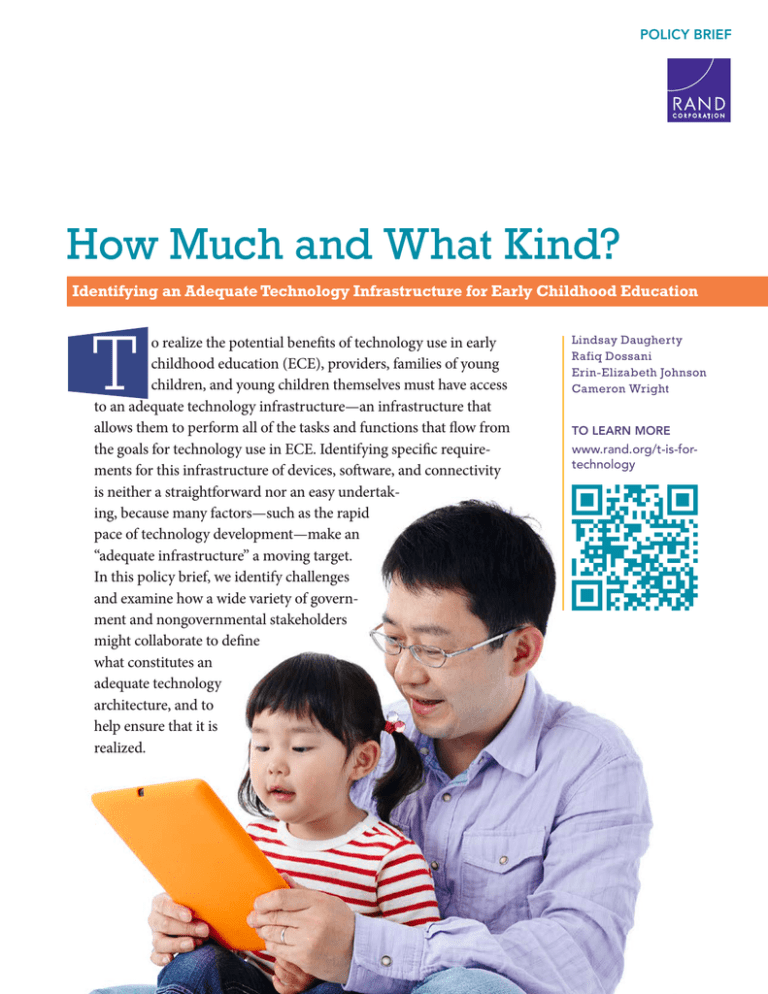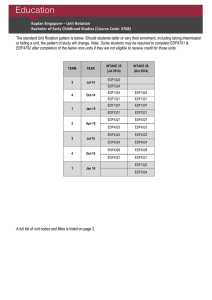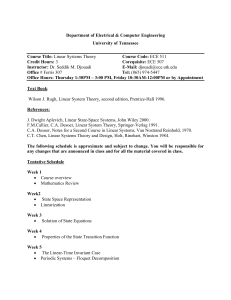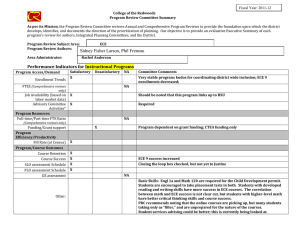T How Much and What Kind?
advertisement

POLICY BRIEF C O R P O R AT I O N How Much and What Kind? Identifying an Adequate Technology Infrastructure for Early Childhood Education T o realize the potential benefits of technology use in early childhood education (ECE), providers, families of young children, and young children themselves must have access to an adequate technology infrastructure—an infrastructure that allows them to perform all of the tasks and functions that flow from the goals for technology use in ECE. Identifying specific requirements for this infrastructure of devices, software, and connectivity is neither a straightforward nor an easy undertaking, because many factors—such as the rapid pace of technology development—make an “adequate infrastructure” a moving target. In this policy brief, we identify challenges and examine how a wide variety of government and nongovernmental stakeholders might collaborate to define what constitutes an adequate technology architecture, and to help ensure that it is realized. Lindsay Daugherty Rafiq Dossani Erin-Elizabeth Johnson Cameron Wright TO LEARN MORE www.rand.org/t-is-fortechnology Why Focus on Technology and Early Childhood Education? Digital literacy—the knowledge and skills needed to use technology “to analyze, learn, and explore”i—plays an important role in a child’s ability to succeed in school and beyond. Yet, despite rapid growth in society’s use of information and communication technology, many children in low-income families in the United States are unable to access technology—including devices, software, and connectivity—in the same ways as their more-advantaged peers. And even when children from low-income families are able to access technology, they often learn to use it in different ways. The result? Fewer opportunities to learn, explore, and communicate digitally, and fewer chances to develop technology skills that might be needed for success in school and the workplace. Technology use in formal early childhood education (ECE) settings, such as preschools and child-care centers, may help shrink the digital divide in terms of both access and use for children in low-income families. Both in and beyond formal ECE settings, technology use may also play a valuable role in ensuring that all children enter kindergarten with early digital literacy skills—and in helping them build skills in such areas as literacy, math, and motor development by providing additional opportunities for exploration, interaction, communication, and creativity. With adequate resources and support, ECE providers and family members may also benefit from technology use in ECE as they lead and encourage the education of young children. Among children ages 3–5, technology use is not without potential pitfalls. Some physicians, policymakers, educators, and parents are concerned that technology use in ECE may have a negative effect on the development of social and gross motor skills, contribute to obesity, and diminish skill development in areas beyond digital literacy. So, as we seek to realize the potential benefits of technology use in ECE, we must also ensure that we address potential harms. Charting the road ahead requires careful thought and planning. A broad group of stakeholders must be invited to the discussion, and their unique perspectives—and, occasionally, competing priorities—must be understood and addressed. We propose that achieving a better understanding of how to integrate technology into ECE requires answering five key questions: 1. What are the goals for technology use in ECE? 2. How do we define developmentally appropriate technology use in ECE? 3. Once defined, how do we support developmentally appropriate technology use through devices, software, connectivity, and other components of technology infrastructure? 4. How do we ensure that ECE providers are prepared to integrate technology appropriately, intentionally, and productively into ECE settings? 5. How can parents and other family members play a role in the use of technology in ECE? Our Approach The study of modern technology use in ECE is, by definition, a relatively nascent field, and research has largely examined only isolated aspects of the topic (with a heavy emphasis on the effects of watching television). Therefore, considerable debate, disagreement, and uncertainty remain, although consensus appears to be forming around the need to integrate technology into ECE in an intentional and productive way. In February 2014, the RAND Corporation published a framing paper, Using Early Childhood Education to Bridge the Digital Divide, that summarized and assessed the existing literature and outlined the five key questions introduced above.ii The paper also described the need to involve a wide range of stakeholders in discussions, planning, and implementation. In May 2014, RAND and PNC Grow Up Great hosted a one-day forum that brought these stakeholders— advocates, educators, researchers, policymakers, funders, and parents—together to discuss issues, needs, evidence, and ideas related to technology use in ECE. Through plenary sessions and smaller breakout groups, the 45 forum participants shared their perspectives on each of the five key questions. This policy brief integrates findings from our literature review with the perspectives of forum participants. Therefore, its contents cannot be considered comprehensive or definitive. Rather, we offer suggestions in the spirit of advancing knowledge and encouraging continued conversation as stakeholders move ahead with policies and programs that support technology use in ECE. i ii ii 2 International Society for Technology in Education, “Digital Age Learning,” web page, copyright 2014. As of August 28, 2014: http://www.iste.org/standards/ standards-for-students L. Daugherty, R. Dossani, E. Johnson, and M. Oguz, Using Early Childhood Education to Bridge the Digital Divide, Santa Monica, Calif.: RAND Corporation, PE-119-PNC, 2014. As of June 6, 2014: www.rand.org/t/PE119 How Much and What Kind? What Is a Technology Infrastructure and Why Does It Matter? It is important to make progress toward understanding the components of a technology infrastructure and what each component can contribute to learning. This is a time of transition for the use of technology in education, and all stakeholder groups, including policymakers, parents and families, providers, and researchers, are grappling with how to define a technology infrastructure in terms of learning standards outcomes. What should children know about technology, and what should they be able to do with it? This is particularly true in the case of the education of young children, where technology has been integrated into learning at a slower pace. As a result, there is still considerable uncertainty about required standards of performance for technology infrastructure. In the absence of such standards, it is important to make progress toward understanding the components of a technology infrastructure and what each component can contribute to learning. We may then address the challenges associated with standardization, beginning with the question of what the standards should seek to achieve. This will help us determine “how much” or “what kind” of each component is needed. There are three critical components of a technology infrastructure: 1. devices (such as tablets, laptops, desktop computers, and smartphones), which provide the physical interface that connects users with both locally stored software and information and services available on the Internet (and other remote data sources). 2. software, which is the set of computer programs that both make devices functional and provide applications (apps) for different functions, such as gaming and word processing. 3. connectivity (whether wired or wireless), which connects users, via devices, to the information and services available on the Internet. Identifying specific requirements for these three components in ECE settings and at home is complex. The universe of devices and software is constantly expanding, as are their capabilities. Furthermore, a certain level of connectivity is often required to operate and fully exploit these capabilities. Several factors make it difficult to identify a suite of adequate devices. The first is that devices are not standardized. For example, the capabilities of one tablet may differ sharply from those of another. So, we cannot simply say that ECE providers must have tablet computers available for their charges. Rather, we must identify what capabilities and affordances of tablet computers are important in ECE settings and then help providers select the appropriate devices. A second challenge to identifying a suite of adequate devices is determining what specific design attributes and affordances make a device suitable—or unsuitable—for use by young children. Portability and durability are important considerations, as children in ECE settings are typically encouraged to move around. Other factors to consider include ease of use, cost, touch sensitivity, screen quality, and picture size and depth. A key challenge in the case of software is that it is developed very rapidly. In January 2013, Apple reported that Identifying an Adequate Technology Infrastructure for Early Childhood Education 3 its App Store was growing by 20,000 apps a month—more than 650 new apps every day.1 As of January 21, 2014, developers had built more than 1.2 million unique apps for the iOS platform used by iPhones, iPads, and iPod Touch devices.2 Furthermore, developers are also working on new programs for other platforms, such as those used by Android devices, Windows-based computers, smart televisions, and videogame consoles. The applications vary in a host of ways that are important to consider in identifying a suite of adequate software for ECE: level of interactivity, languages supported, cost to purchase and update, dependence on device features (such as cameras) for full functionality, ease of use, and purpose and quality of content, to name but a few. Identifying potentially appropriate software out of the myriad available options, and then vetting individual applications, is a significant undertaking, and, according to forum participants who are ECE providers, one that cannot be shouldered by teachers or families alone. Of the three components, connectivity presents the fewest challenges because it is the most standardized. Connectivity can be achieved through one or more of a mere handful of technologies, including wired and wireless technologies, that connect the user to a network of remote servers that offer Internet and other data access. But once connectivity is established and the user accesses the Internet, it is bandwidth that determines how quickly information can be uploaded from or downloaded to a device. Once we have established which devices and software constitute an adequate technology infrastructure, it is possible, in theory, to identify how much bandwidth is required to operate and fully exploit the capabilities of selected devices and software. A potential challenge to identifying what constitutes an adequate technology architecture stems from how quickly new technologies, especially devices and software, are being introduced and rendered obsolete. What is adequate in 2014 might not be adequate in 2015. A technology widely available now might be eclipsed by a new discovery down the line. Establishing standards might help mitigate this challenge, as this would help us better judge whether a new device, for example, is suitable for use in ECE settings. However, new technologies may 4 A potential challenge to identifying what constitutes an adequate technology architecture stems from how quickly new technologies, especially devices and software, are being introduced and rendered obsolete. change ways of learning, with tablets and smartphones being two recent examples of devices with this potential. When the first iPad was launched in 2010, many people involved in making decisions about technology in education might not have visualized its use in ECE settings. As the iPad’s potential became clearer, earlier (often costly) investments in devices, software, and connectivity might have become obsolete. We do not suggest that children must always use the latest available technology. Although keeping pace with advances might help meet the goal of building digital literacy, “older” technologies might still be adequate to support other learning, skills, and school readiness goals. However, to the extent that new technologies significantly change the potential for learning, new standards may need to be developed to capture these capacities. Less-advantaged children might be the last to benefit from new advances due to the high cost of keeping pace with devices, software, and connectivity. Those involved in identifying an adequate technology architecture for ECE should be well informed about technology choices and trends, so they can choose device, software, and connectivity options that are most likely to meet evolving learning standards. This brings us to our next question: Who is best placed to determine what constitutes an adequate technology architecture, and who will be involved in making sure that it is realized? Who Is Best Positioned to Do What? Forum participants agreed that a wide variety of organizations must be involved in defining what constitutes an How Much and What Kind? adequate technology architecture and ensuring that it is realized. Potential stakeholders include government agencies, technology developers, technology users (providers, parents and families, and those who educate and provide professional development to providers), researchers, advocates, and foundations. Government agencies, for example, can be helpful in guiding other stakeholders as they develop practices that can help the government set policy standards. For example, government agencies can support research into the capabilities of specific technology systems, and may also play a useful role when markets fail to provide necessary services at reasonable costs. One such common market failure is connectivity in ECE settings. Many ECE providers who care for children from low-income families cannot afford the access rates set by telecommunications companies.3 The government might have a role to play in making connectivity affordable. What role stakeholders are best equipped to play depends on their capacity to address challenges. Thus, one way to determine the appropriate role for each stakeholder is to (1) identify discrepancies in the access and use of technology between children in low-income families and their more-advantaged peers that are likely to persist, and (2) assess the capacity of different stakeholders to address these discrepancies. Discrepancies exist and are likely to persist in all three components of the technology infrastructure for ECE.4 For example, poorer schools and homes are less likely to have the latest generation of tablets, “always on” highspeed bandwidth, and the most sophisticated software.5 Which stakeholders are best positioned to address these discrepancies? Devices Researchers, supported by foundations, and working closely with device developers, are the stakeholders best positioned to identify the affordances and features of appropriate needed devices. Government agencies and other stakeholders can then play a role in ensuring that all children have access to suitable devices that deliver the needed capabilities. As noted earlier, specific design attributes can make a device suitable—or unsuitable—for young children; indeed, devices that are large or heavy, or whose screens are very small, may pose risks for young users. Researchers could help establish guidelines for screen size, device weight, and other important characteristics, and then work with policymakers to assess the feasibility of setting national standards that the federal government and state agencies could support through funding and other incentives. Forum participants noted that, given how quickly new devices are developed, this research needs to be ongoing and conducted in a timely fashion. They also suggested that researchers and technology developers need to work more closely together. Close collaboration between researchers and technology developers would put researchers in a position to understand technology trends and incorporate this information into their experiments. At the same time, technology developers would learn about needs and about how their products and services do or do not address needs and standards. Software Identifying and developing appropriate software will require collaboration among several different stakeholders. As noted earlier, applications vary widely in terms of languages supported, functions, etc., which makes categorization and standardization more difficult. In addition, the rapid proliferation of new software requires that any agreed-upon categories and standards will need to be frequently revised to avoid becoming obsolete. Government efforts that consider the content of software in the context of identifying effective curricula and practices—such as the What Works Clearinghouse initiative6— are likely to be more effective when supported by independent research and trials undertaken by nongovernmental stakeholders, including researchers and practitioners. This would further the goal of establishing national standards for learning outcomes from software. Once such standards are established, software developers would have an incentive to develop software that meets them. According to several forum participants, until such standards are established, software designers and ECE Identifying an Adequate Technology Infrastructure for Early Childhood Education 5 providers should collaborate directly in the development of applications. This would help software designers better understand the needs of providers. Forum participants suggested that foundations and advocates could play a role in facilitating this collaboration. Nonprofit funding bodies, such as private foundations, could consider funding research into how to rate software in a way that is useful to ECE providers and families— perhaps in terms of key learning outcomes (such as the development of particular cognitive skills). They could then make rating guidelines freely available over the Internet for use by ECE providers and families. Communities of application users could be encouraged to discuss the ratings and provide feedback. These ratings could incorporate the work of many commercial sites, such as Common Sense Media, Children’s Technology Review, and EdSurge, that are set up to track new educational software and categorize applications in multiple ways, such as by age of targeted users, curriculum type, device compatibility, and cost. Connectivity Government agencies may be well positioned to help address discrepancies in connectivity. The federal government has played an important role in ensuring connectivity for public and private schools through the E-Rate program, which provides funding for up to 90 percent of the cost of Internet access.7 However, the program is not uniformly available to ECE providers across the country. Eligibility for E-Rate is decided by state governments,8 and some states have declined to participate. Of those that have joined the program, 16 states—representing 43.7 percent of the country’s population—have qualified all Head Start preschools, whether they are stand-alone facilities or part of a public school district, for the E-Rate program. An additional eight states—representing 21.1 percent of the country’s population—have qualified all ECE schools that are part of a public school district. Currently, however, neither home-based Head Start facilities nor Early Head Start facilities are eligible for the E-Rate 6 program. Federal policymakers should consider expanding eligibility for E-Rate to all Head Start programs and settings. Another related priority is to encourage states that have not yet joined the E-Rate program to do so. This is an assignment for which civil-society advocates may be well suited. Ensuring connectivity in the home is also important. Parents and other family members play an important role as “teachers” during time spent outside ECE settings, and parental roles in technology use and joint engagement with media appear to be important in building children’s technology literacy.9 Some local governments are partnering with private firms to provide wireless access free of charge either citywide or in specific zones.10 There may also be a role for foundations and other stakeholders in ensuring sufficient connectivity in the home. The Bottom Line To realize the potential benefits of technology use in ECE, including its ability to help address the digital divide, providers, families of young children, and young children themselves must have access to an adequate technology infrastructure—an infrastructure that allows them to perform all of the tasks and functions that flow from the goals for technology use in ECE. This infrastructure comprises adequate devices, appropriate software, and Internet connectivity. But identifying specific requirements for these three components in ECE settings and at home is neither a straightforward nor an easy undertaking. A wide variety of organizations must be involved in defining what constitutes an adequate technology architecture and ensuring that it is realized. Many factors—such as the rapid pace of technology development—make an “adequate infrastructure” a moving target. Developing standards is a critical step in defining, measuring, and achieving such an infrastructure. Meanwhile, there is work to be done in other areas, such as subsidizing connectivity and developing robust ratings for devices and software. How Much and What Kind? Sources 1 D. Rowinski, “Apple iOS App Store Adding 20,000 Apps A Month, Hits 40 Billion Downloads,” Readwrite.com, January 7, 2013. As of July 17, 2014: http://readwrite.com/2013/01/07/apple-app-store-growing-by 2 Apple.com, “Apple Releases iOS 8 SDK with over 4,000 New APIs,” press release, June 2, 2014. As of July 17, 2014: https://www.apple.com/pr/library/2014/06/ 02Apple-Releases-iOS-8-SDK-With-Over-4-000-New-APIs.html 3 A. Goolsbee and J. Guryan, “The Impact of Internet Subsidies in Public Schools,” The Review of Economics and Statistics, Vol. 88, No. 2, 2006, pp. 336–347. 4 T. File, “Computer and Internet Use in the United States: Population Characteristics,” U.S. Census Bureau, May 2013; National Telecommunications and Information Administration, Digital Nation: Expanding Internet Usage, Washington, D.C.: U.S. Department of Commerce, 2011. 5 E. Wartella, C. K. Blackwell, A. R. Lauricella, and M. Robb, Technology in the Lives of Teachers and Classrooms, Pittsburgh, Pa.: Fred Rogers Center, 2013; Pew Internet and American Life Project, Spring Tracking Survey 2012: Data for March 15–April 3, 2012, Washington, D.C., April 10, 2012. 6 Institute of Education Sciences, “Early Childhood Education,” web page, undated. As of July 17, 2014: http://ies.ed.gov/ncee/wwc/Topic.aspx?sid=4 7 Universal Service Administrative Company, “Schools and Libraries (E-Rate),” web page, copyright 1997–2014. As of July 10, 2014: http://www.usac.org/sl/; Education and Library Networks Coalition, “Get the Facts: Frequently Asked Questions,” web page, undated. As of July 10, 2014: http://www.edlinc.org/ get_facts.html#What%20does%20the%20E-Rate%20provide 8 Head Start, “Head Start E-Rate Eligibility,” web page, updated May 2012. As of July 10, 2014: http://eclkc.ohs.acf.hhs.gov/hslc/tta-system/operations/fiscal/erate-toolkit/ manage_too_00524_082907.html 9 B. Barron, C. K. Martin, L. Takeuchi, and R. Fithian, “Parents as Learning Partners in the Development of Technological Fluency,” International Journal of Learning and Media, Vol. 1, No. 2, 2009, pp. 55–77. 10 MuniWireless, “Archives for City and County WiFi Networks,” web page, last updated on June 4, 2014. As of July 18, 2014: http://www.muniwireless.com/category/city-county-wifi-networks/ Identifying an Adequate Technology Infrastructure for Early Childhood Education 7 The RAND Corporation gratefully acknowledges the PNC Foundation, the sponsor of this research. Among other initiatives, PNC supports early education through PNC Grow Up Great, a $350 million, multi-year, bilingual initiative that began in 2004 to help prepare children from birth to age five for success in school and life. The project was conducted within RAND Education, a division of the RAND Corporation. Its mission is to bring accurate data and careful, objective analysis to the national debate on education policy. For more information and resources on technology in early childhood education, please visit www.rand.org/t-is-for-technology. The authors wish to thank Chip Donohue, Gail L. Zellman, and Cathy Stasz for their reviews of this manuscript. Front cover photo: tetsuomorita/iStock; back cover: CEFutcher/iStock The RAND Corporation develops solutions to public policy challenges to help make communities throughout the world safer and more secure, healthier and more prosperous. R® A is a registered trademark. www.rand.org 8 © Copyright 2014 RAND Corporation RR-673/3-PNC (2014) How Much and What Kind? CHILDREN AND FAMILIES EDUCATION AND THE ARTS The RAND Corporation is a nonprofit institution that helps improve policy and decisionmaking through research and analysis. ENERGY AND ENVIRONMENT HEALTH AND HEALTH CARE INFRASTRUCTURE AND TRANSPORTATION This electronic document was made available from www.rand.org as a public service of the RAND Corporation. INTERNATIONAL AFFAIRS LAW AND BUSINESS NATIONAL SECURITY POPULATION AND AGING PUBLIC SAFETY SCIENCE AND TECHNOLOGY TERRORISM AND HOMELAND SECURITY Support RAND Browse Reports & Bookstore Make a charitable contribution For More Information Visit RAND at www.rand.org Explore the RAND Corporation View document details Limited Electronic Distribution Rights This document and trademark(s) contained herein are protected by law as indicated in a notice appearing later in this work. This electronic representation of RAND intellectual property is provided for noncommercial use only. Unauthorized posting of RAND electronic documents to a non-RAND website is prohibited. RAND electronic documents are protected under copyright law. Permission is required from RAND to reproduce, or reuse in another form, any of our research documents for commercial use. For information on reprint and linking permissions, please see RAND Permissions.




